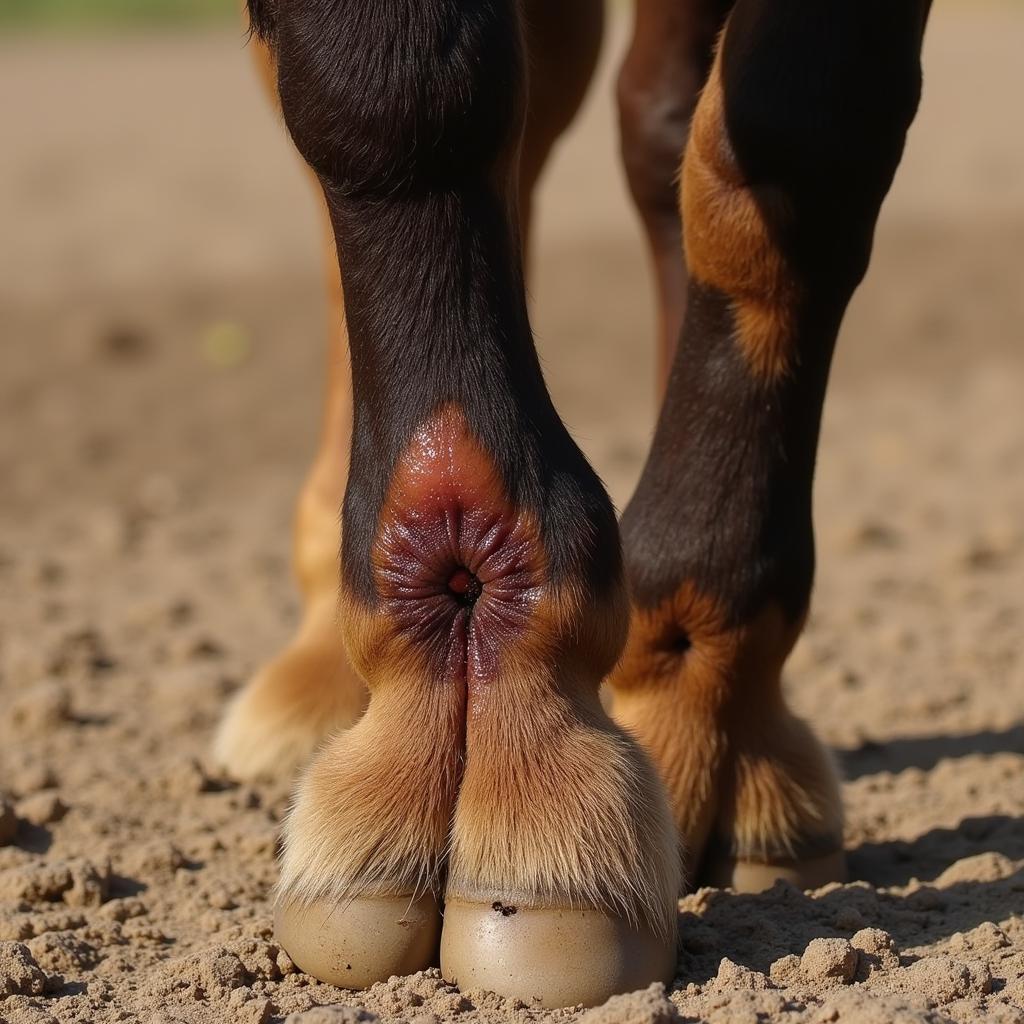Foxtail Grass And Horses are a dangerous combination. These seemingly innocuous grasses pose a serious threat to equine health. Learn how to identify, prevent, and manage foxtail related issues in your horses.
Identifying the Threat: What is Foxtail Grass?
Foxtail grasses are a group of weedy grasses characterized by their distinctive, bristly seed heads that resemble a fox’s tail. These seed heads are designed for dispersal, easily attaching to animal fur, clothing, and even skin. While seemingly harmless, these barbed seed heads can cause significant problems for horses.
Types of Foxtail and Their Habitats
Several species of foxtail exist, including yellow foxtail, green foxtail, and giant foxtail. These grasses thrive in disturbed areas, overgrazed pastures, and along roadsides. Their adaptability and prolific seed production make them a persistent problem for horse owners.
Why Foxtail Grass is Dangerous for Horses
The danger of foxtail grass lies in the barbed seed heads. These barbs allow the seed heads to burrow into a horse’s skin, mouth, nose, eyes, and even genitals. Once embedded, the foxtail migrates further into the tissue, causing irritation, infection, and abscesses.  Horse with Foxtail Injury on its Leg
Horse with Foxtail Injury on its Leg
Common Entry Points and Symptoms
Foxtails can enter a horse through various routes. Ingestion is a common concern, leading to mouth sores, difficulty swallowing, and even digestive issues. Inhalation can cause respiratory problems, including coughing and nasal discharge. Foxtails can also become embedded in the skin, particularly around the feet, legs, and face, leading to painful swelling and infection. millet hay for horses
Preventing Foxtail Exposure in Horses
Minimizing foxtail exposure is crucial for protecting your horse’s health. Regular pasture management is key. Mowing pastures before the foxtail goes to seed can significantly reduce the risk. millet hay for horses
Pasture Management and Other Preventative Measures
Maintaining healthy, dense pastures can also help outcompete foxtail growth. Consider using herbicides specifically designed for foxtail control. If foxtail is prevalent in your area, consider using grazing muzzles to prevent ingestion. Regularly inspect your horse for foxtails, especially after they have been in areas where foxtail is present.
Treating Foxtail-Related Issues in Horses
If you suspect your horse has a foxtail embedded, it’s essential to seek veterinary care promptly. Early intervention can prevent further complications and reduce the risk of serious infection.
Veterinary Care and Home Management
Your veterinarian may need to surgically remove the foxtail. They may also prescribe antibiotics to treat any existing infections. After veterinary care, careful home management is essential. Keep the affected area clean and dry, and follow your veterinarian’s instructions for wound care.
How to Spot Foxtail in Your Horse’s Hay
Inspecting your horse’s hay for foxtail is a vital part of preventative care. Look closely for the characteristic seed heads. Remove any contaminated hay immediately.
Tips for Identifying and Removing Foxtail from Hay
Spread a small amount of hay on a clean surface and visually inspect it for foxtails. If you find foxtails, discard the entire bale to avoid risking your horse’s health. Consider purchasing hay from reputable suppliers who prioritize foxtail control in their fields.
Quote from Dr. Emily Carter, DVM: “Foxtail injuries can be incredibly painful and debilitating for horses. Early detection and prompt veterinary care are essential for a successful outcome.”
Quote from Sarah Miller, Equine Specialist: “Regular pasture management and careful hay selection are the best ways to protect your horses from the dangers of foxtail.”
Conclusion
Foxtail grass and horses can be a dangerous mix. Understanding the risks, taking preventative measures, and seeking prompt veterinary care are essential for safeguarding your horse’s well-being. By being proactive and vigilant, you can help keep your horses safe from this hidden threat.
FAQs
- What does foxtail grass look like?
- What are the symptoms of foxtail ingestion in horses?
- How can I prevent foxtail in my pastures?
- Can horses recover from foxtail injuries?
- What should I do if I find a foxtail embedded in my horse?
- Where can I buy foxtail-free hay?
- How serious are foxtail infections in horses?
For further information on horse care, visit our article on millet hay for horses. You might also be interested in learning more about other potential hazards in your horse’s environment.
When you need help, please contact us: Phone: 0772127271, Email: [email protected] or visit us at QGM2+WX2, Vị Trung, Vị Thuỷ, Hậu Giang, Việt Nam. We have a 24/7 customer service team.